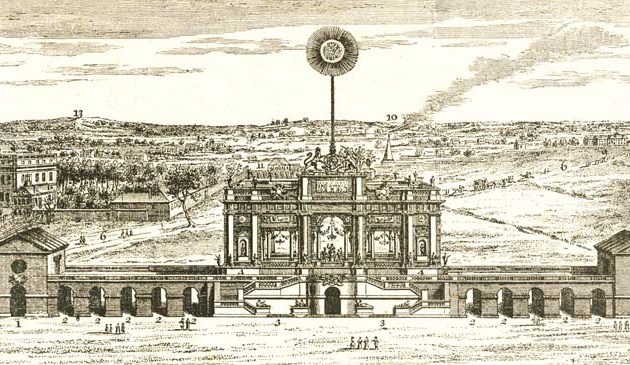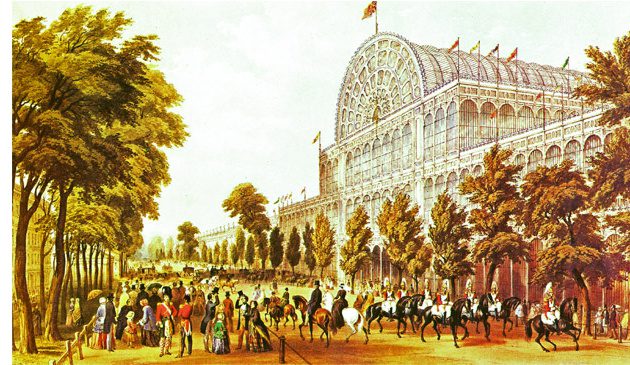Kensington Palace and Gardens

The West Front of Kensington Palace. It is separated from the adjacent street of Kensington Palace Gardens by Palace Green. Kensington Palace Gardens is now perhaps the most exclusive address in London, with houses selling for tens of millions of pounds. It was laid out in the 1840s over what was previously the kitchen gardens of the palace.
William died at the palace in 1702 following a riding accident at Hampton Court. Mary’s sister, Queen Anne, who succeeded William, spent less time at Kensington, preferring instead Hampton Court Palace. Nevertheless, further additions and modifications were made to the palace during her short reign. Thirty acres were added to the gardens, north of where the orangery now stands. It seems that the eastern boundary of the palace and gardens, dividing it from Hyde Park, were then roughly in line with what is now the Broad Walk.
Wise continued as Anne’s gardener. Queen Mary’s box hedges were removed, a kitchen garden was created, and gravel pits to the north of the palace were made into a picturesque wilderness. Fountains and an alcove were added to the south, which were moved to Lancaster Gate in the 1860s. A paddock was created stretching towards Hyde Park and stocked with deer and antelope. The most significant addition during Anne’s reign was the orangery, designed by Sir Christopher Wren and Nicholas Hawksmoor, where oranges and other exotic plants could be grown. Finished in 1705, the greenhouse was splendid enough for the Queen to hold summer parties.
When Anne died, George, Elector of Hanover, took the throne. Arriving in Britain he liked Kensington Palace. However, by then it required renovation and the old Jacobean State Apartments were replaced between 1718 and 1722. A pedimented façade on the East Front was added, which still remains a prominent feature.
George sought someone of outstanding talent to decorate the palace. The leading British artist of the time, Sir James Thornhill, provided a price. However, William Kent, a young protégé of the Earl of Burlington, submitted a lower quote and won the commission. He began by decorating the Cupola Room. George was happy with the results but others were more critical of Kent’s somewhat glitzy Italianate style. Kent filled the palace with art and fine furniture and decorated several other rooms, as well as re-modelling William III’s King’s Gallery. Of special note is Kent’s King’s Staircase that features life-size characters from the royal court. The work launched Kent’s career and he became one of the most influential architects and gardeners of his generation.
The palace was expanded with a series of apartments around courtyards to the north-west, occupied by members of the King’s family as well as his mistress. The gardens of Kensington Palace were enlarged by a further 300 acres in around 1727 by taking away about half of Hyde Park. A boundary was created in the form of a ditch known as the ‘ha-ha’, which prevented entry into the gardens from Hyde Park but without impeding the views from the palace. A ha-ha was a wall or boundary that was not apparent from a distance and therefore came as a surprise to anyone approaching. They were a feature of some country houses in the 18th century. It is most likely that the Kensington Gardens ha-ha was introduced by either Kent or the recently-appointed royal gardener Charles Bridgeman. Semi-circular bastions were created at angles on the ha-ha, faced with brick, and guards were stationed along the boundary to prevent entry by any unauthorised person.
Late in George’s reign various exotic animals were added to the paddock, including tigers, civet cats, tortoises, and snails. When his son came to the throne in 1727 they were all moved to the Tower of London.
George II and his wife Queen Caroline enjoyed entertaining at Kensington Palace and Caroline held solons for the greatest minds of the time. One notable occasion was a visit in 1734 by a delegation of settlers from the new American colony of Georgia, named after the King. It included the native chieftain Tomochichi of the Yamacraw tribe.
Caroline had the enlarged gardens re-modelled by Bridgeman, largely as they remain today. Queen Mary’s gardens to the south of the palace were swept away as too expensive to maintain. Anne’s flower borders were removed and replaced by lawns, promenades and vistas. The Broad Walk and the seven-acre Round Pond ornamental lake were added at that time. Avenues of trees radiated out from the lake.
The Westbourne Brook, which rises in Hampstead and flows to the Thames, passed into the north-east part of the gardens, through a string of ten or more large and small marshy ponds. Charles Withers, Surveyor-General of the Woods and Forests, was employed by Caroline to dam the stream to form an ornamental lake, or ’serpentine river’ at a cost of £6,000. The eastern section of the lake (the Serpentine) is in Hyde Park, while the western section (the Long Water) is in Kensington Gardens. A small cascade separated the two lakes. Until that time ornamental lakes were of a regular shape. The Long Water and Serpentine were created in a more natural-looking curve, starting a new fashion that was copied around the country. (The Westbourne continues its journey down to the Thames through Chelsea. It has long been covered over but the conduit through which it flows can be seen passing above the tracks at Sloane Square station).
Deer were introduced to the gardens and foxes were hunted. A hill was also created in the south-east of the gardens, designed by Kent and built by Bridgeman, known as ‘the Mount’, with soil excavated from the creation of the Serpentine. There were splendid views from there across the entire gardens and at its peak stood a revolving ‘prospect house’ to “afford shelter from the wind”.
King George believed that Caroline was paying for all the work in the gardens and only after her death discovered that Prime Minister Robert Walpole had secretly agreed £20,000 from the King’s funds.
Caroline and her bevy of maidens would promenade in the gardens, displaying the latest clothes, notably skirts with newly-introduced types of farthingale petticoats. Members of the public who wore full dress were allowed into the gardens on Saturdays, later changed to Sundays. Ladies, especially, were eager to see the new fashions of Caroline and her courtiers and to feel privileged to be among the first to witness them, somewhat similar to modern fashion shows. The garden’s Broad Walk was almost as popular a place to promenade in the 18th century as the Mall in St. James’s Park in the previous century.
Caroline died in 1737 and thereafter the palace was largely neglected, falling into a state of disrepair. George reviewed his troops in Hyde Park in October 1760 and died suddenly in the palace two days later while having breakfast. He was the last monarch to stay at Kensington Palace. His grandson and successor, George III, disliked the place, preferring instead the palaces at St. James’s and Kew. From the 1790s parts of the palace became home to two of his sons, Augustus, Duke of Sussex, and Edward, Duke of Kent, father of Queen Victoria. Thereafter Kensington continued in use as the home of minor members of the royal family.


